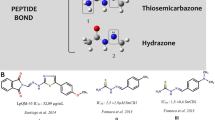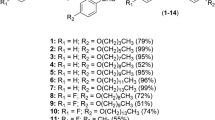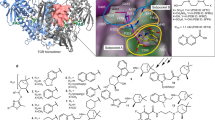Abstract
Treatment for schistosomiasis, which is responsible for more than 280,000 deaths annually, depends almost exclusively on praziquantel. Millions of people are treated annually with praziquantel, and drug-resistant parasites thus are likely to evolve. Phosphinic amides and oxadiazole 2-oxides, identified from a quantitative high-throughput screen, were shown to inhibit a parasite enzyme, thioredoxin glutathione reductase (TGR), with activities in the low micromolar to low nanomolar range. Incubation of parasites with these compounds led to rapid inhibition of TGR activity and parasite death. The activity of the oxadiazole 2-oxides was associated with a donation of nitric oxide. Treatment of schistosome-infected mice with 4-phenyl-1,2,5-oxadiazole-3-carbonitrile-2-oxide led to marked reductions in worm burdens from treatments against multiple parasite stages and egg-associated pathologies. The compound was active against the three major schistosome species infecting humans. These protective effects exceed benchmark activity criteria set by the World Health Organization for lead compound development for schistosomiasis.
This is a preview of subscription content, access via your institution
Access options
Subscribe to this journal
Receive 12 print issues and online access
$209.00 per year
only $17.42 per issue
Buy this article
- Purchase on Springer Link
- Instant access to full article PDF
Prices may be subject to local taxes which are calculated during checkout



Similar content being viewed by others
References
Hotez, P.J. et al. Control of neglected tropical diseases. N. Engl. J. Med. 357, 1018–1027 (2007).
van der Werf, M.J. et al. Quantification of clinical morbidity associated with schistosome infection in sub-Saharan Africa. Acta Trop. 86, 125–139 (2003).
King, C.H., Dickman, K. & Tisch, D.J. Reassessment of the cost of chronic helminthic infection: a meta-analysis of disability-related outcomes in endemic schistosomiasis. Lancet 365, 1561–1569 (2005).
Steinmann, P., Keiser, J., Bos, R., Tanner, M. & Utzinger, J. Schistosomiasis and water resources development: systematic review, meta-analysis, and estimates of people at risk. Lancet Infect. Dis. 6, 411–425 (2006).
Fenwick, A. & Webster, J.P. Schistosomiasis: challenges for control, treatment and drug resistance. Curr. Opin. Infect. Dis. 19, 577–582 (2006).
Herwaldt, B.L., Tao, L.F., van Pelt, W., Tsang, V.C. & Bruce, J.I. Persistence of Schistosoma haematobium infection despite multiple courses of therapy with praziquantel. Clin. Infect. Dis. 20, 309–315 (1995).
Murray-Smith, S.Q., Scott, B.J., Barton, D.P. & Weinstein, P. A case of refractory schistosomiasis. Med. J. Aust. 165, 458 (1996).
Ismail, M. et al. Resistance to praziquantel: direct evidence from Schistosoma mansoni isolated from Egyptian villagers. Am. J. Trop. Med. Hyg. 60, 932–935 (1999).
Fallon, P.G. & Doenhoff, M.J. Drug-resistant schistosomiasis: resistance to praziquantel and oxamniquine induced in Schistosoma mansoni in mice is drug specific. Am. J. Trop. Med. Hyg. 51, 83–88 (1994).
Utzinger, J., Xiao, S.H., Tanner, M. & Keiser, J. Artemisinins for schistosomiasis and beyond. Curr. Opin. Investig. Drugs 8, 105–116 (2007).
Cioli, D., Pica-Mattoccia, L. & Archer, S. Drug resistance in schistosomes. Parasitol. Today 9, 162–166 (1993).
Abdulla, M.H., Lim, K.C., Sajid, M., McKerrow, J.H. & Caffrey, C.R. Schistosomiasis mansoni: novel chemotherapy using a cysteine protease inhibitor. PLoS Med. 4, e14 (2007).
Moreira, L.S., Piló-Veloso, D., de Mello, R.T., Coelho, P.M. & Nelson, D.L. A study of the activity of 2-(alkylamino)-1-phenyl-1-ethanethiosulfuric acids against infection by Schistosoma mansoni in a murine model. Trans. R. Soc. Trop. Med. Hyg. 101, 385–390 (2007).
Townsend, D.M., Tew, K.D. & Tapiero, H. The importance of glutathione in human disease. Biomed. Pharmacother. 57, 145–155 (2003).
Lillig, C.H. & Holmgren, A. Thioredoxin and related molecules-from biology to health and disease. Antioxid. Redox Signal. 9, 25–47 (2007).
Alger, H.M. & Williams, D.L. The disulfide redox system of Schistosoma mansoni and the importance of a multifunctional enzyme, thioredoxin glutathione reductase. Mol. Biochem. Parasitol. 121, 129–139 (2002).
Kuntz, A.N. et al. Thioredoxin glutathione reductase from Schistosoma mansoni: an essential parasite enzyme and a key drug target. PLoS Med. 4, e206 (2007).
Inglese, J. et al. Quantitative high-throughput screening: a titration-based approach that efficiently identifies biological activities in large chemical libraries. Proc. Natl. Acad. Sci. USA 103, 11473–11478 (2006).
Simeonov, A. et al. Quantitative high-throughput screen identifies inhibitors of the Schistosoma mansoni redox cascade. PLoS Negl. Trop. Dis 2, e127 (2008).
Ramirez, B. et al. Schistosomes: challenges in compound screening. Expert Opin. Drug Discov. 2 (Suppl. 1), S53–S61 (2007).
Feelisch, M., Schönafinger, K. & Noack, E. Thiol-mediated generation of nitric oxide accounts for the vasodilator action of furoxans. Biochem. Pharmacol. 44, 1149–1157 (1992).
Akaike, T. et al. Antagonistic action of imidazolineoxyl N-oxides against endothelium-derived relaxing factor/NO through a radical reaction. Biochemistry 32, 827–832 (1993).
Trouiller, P. et al. Drug development for neglected diseases: a deficient market and a public-health policy failure. Lancet 359, 2188–2194 (2002).
Austin, C.P., Brady, L.S., Insel, T.R. & Collins, F.S. NIH Molecular Libraries Initiative. Science 306, 1138–1139 (2004).
Cerecetto, H. & Porcal, W. Pharmacological properties of furoxans and benzofuroxans: recent developments. Mini Rev. Med. Chem. 5, 57–71 (2005).
James, S.L. & Glaven, J. Macrophage cytotoxicity against schistosomula of Schistosoma mansoni involves arginine-dependent production of reactive nitrogen intermediates. J. Immunol. 143, 4208–4212 (1989).
Medana, C. et al. Furoxans as nitric oxide donors. 4-Phenyl-3-furoxancarbonitrile: thiol-mediated nitric oxide release and biological evaluation. J. Med. Chem. 37, 4412–4416 (1994).
Nordberg, J. & Arner, E.S. Reactive oxygen species, antioxidants, and the mammalian thioredoxin system. Free Radic. Biol. Med. 31, 1287–1312 (2001).
Nwaka, S. & Hudson, A. Innovative lead discovery strategies for tropical diseases. Nat. Rev. Drug Discov. 5, 941–955 (2006).
Sabah, A.A., Fletcher, C., Webbe, G. & Doenhoff, M.J. Schistosoma mansoni: chemotherapy of infections of different ages. Exp. Parasitol. 61, 294–303 (1986).
Shuhua, X., Chollet, J., Weiss, N.A., Bergquist, R.N. & Tanner, M. Preventive effect of artemether in experimental animals infected with Schistosoma mansoni. Parasitol. Int. 49, 19–24 (2000).
Lewis, F. Schistosomiasis. in Current Protocols in Immunology (eds. Coligan, J.E., Kruisbeek, A.M., Margulies, D.H., Shevach, E.M. & Strober, W.) 19.1.1–19.1.28 (John Wiley & Sons, New York, 1998).
Bergmeyer, H.U. & Bernt, E. Lactate dehydrogenase. in Methods of Enzymatic Analysis Vol. 2 (ed. Bergmeyer, H.U.) 574–548 (Academic Press, New York, 1974).
Aguirre, G. et al. Furoxan derivatives as cytotoxic agents: preliminary in vivo antitumoral activity studies. Pharmazie 61, 54–59 (2006).
Skehan, P. et al. New colorimetric cytotoxicity assay for anticancer-drug screening. J. Natl. Cancer Inst. 82, 107–112 (1990).
Nims, R.W. et al. Colorimetric methods for the determination of nitric oxide concentration in neutral aqueous solutions. Methods 7, 48–54 (1995).
Acknowledgements
This work was supported in part by US National Institutes of Health (NIH)/National Institute of Mental Health grant R03MH076449 (D.L.W.) and by NIH/National Institute of Allergy and Infectious Diseases (NIAID) grant R01AI065622 (D.L.W.), and in part by the NIH Roadmap for Medical Research Molecular Libraries Program. Schistosome life stages used in this research were supplied in part by the NIAID Schistosomiasis Resource Center at the Biomedical Research Institute (Rockville, Maryland, USA) through NIAID Contract N01-AI-30026.
Author information
Authors and Affiliations
Contributions
A.A.S., A.S. and D.L.W. designed the research. A.A.S. performed enzyme, cultured worm and in vivo experiments. A.A.S. and D.L.W. analyzed the data. C.J.T. and A.S. contributed oxadiazole 2-oxide reagents. A.A.S., D.L.W., A.S., J.I., C.J.T. and C.P.A. discussed the results and wrote the paper.
Corresponding authors
Supplementary information
Supplementary Text and Figures
Supplementary Figs. 1 and 2 (PDF 347 kb)
Rights and permissions
About this article
Cite this article
Sayed, A., Simeonov, A., Thomas, C. et al. Identification of oxadiazoles as new drug leads for the control of schistosomiasis. Nat Med 14, 407–412 (2008). https://doi.org/10.1038/nm1737
Received:
Accepted:
Published:
Issue Date:
DOI: https://doi.org/10.1038/nm1737
This article is cited by
-
Synthesis of New Thiadiazole-2-Oxides as Potential Antischistosomal Agents
Pharmaceutical Chemistry Journal (2022)
-
Synthesis of oxadiazole-2-oxide derivatives as potential drug candidates for schistosomiasis targeting SjTGR
Parasites & Vectors (2021)
-
SET activation of nitroarenes by 2-azaallyl anions as a straightforward access to 2,5-dihydro-1,2,4-oxadiazoles
Nature Communications (2021)
-
In vitro and in vivo evaluation of cnicin from blessed thistle (Centaurea benedicta) and its inclusion complexes with cyclodextrins against Schistosoma mansoni
Parasitology Research (2021)
-
In vitro and in vivo activities of DW-3-15, a commercial praziquantel derivative, against Schistosoma japonicum
Parasites & Vectors (2019)



